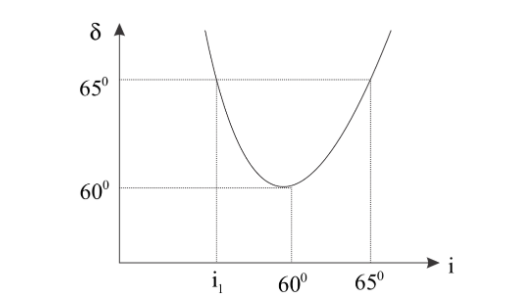
The angle of deviation $(\delta )$ vs angle of incidence $(i)$ is plotted for a prism. Pick up the correct statements.

(A) The angle of the prism is ${60^0}$.
(B) The refractive index of prism is $n = \sqrt 3 $.
(C) The curve of $\delta {\text{ vs }}i$ is parabolic.
(D) For the deviation to be ${65^0}$ the angle of incidence to be ${i_1} = {55^0}$.
Answer
218.7k+ views
Hint We know that deviation of prism is given by $\delta = i + e - A$, where $\delta $ is deviation, $i$ is angle of incidence, $e$ is angle of emergence and $A$ is angle of prism. For minimum deviation, $i = e$. Using these equations, we find the angle of the prism. Using minimum deviation, we find a refractive index of prism. After this, find ${i_1}$ using the given information.
Complete step by step solution
We know that deviation of prism is given by $\delta = i + e - A$, where $\delta $ is deviation, $i$ is angle of incidence, $e$ is angle of emergence and $A$ is angle of prism. For minimum deviation, $i = e$.
From the figure, for minimum deviation, $\delta = {60^0}$ and also ${i_1} = {60^0}$.
For minimum deviation, $\delta = 2i - A$ or $A = 2i - \delta $.
After putting value in above equation, we get
$A = 2 \times 60 - 60 = {60^0}$.
Now refractive of given is given by
$n = \dfrac{{\sin \left( {\dfrac{{A + \delta }}{2}} \right)}}{{\sin \dfrac{A}{2}}}$
Then, $n = \dfrac{{\sin 60}}{{\sin 30}} = \sqrt 3 $.
Here for angle of deviation ${65^0}$, angle of emergence is given in figure that is $e = {70^0}$,
Then, ${\delta _1} = {i_1} + e - A$ or ${i_1} = {\delta _1} - e + A$
${i_1} = 65 - 70 + 60 = {55^0}$.
From the graph we can see that the curve of $\delta {\text{ vs }}i$ is parabolic.
Hence all options are correct.
Note We know that of each angle of deviation there are two points on the graph, these two are angle of incidence and angle of emergence and always exist in pairs. These angles are such that if we take angle of emergence as angle of incidence the angle of emergence for that case is angle of incident of given case.
Complete step by step solution
We know that deviation of prism is given by $\delta = i + e - A$, where $\delta $ is deviation, $i$ is angle of incidence, $e$ is angle of emergence and $A$ is angle of prism. For minimum deviation, $i = e$.
From the figure, for minimum deviation, $\delta = {60^0}$ and also ${i_1} = {60^0}$.
For minimum deviation, $\delta = 2i - A$ or $A = 2i - \delta $.
After putting value in above equation, we get
$A = 2 \times 60 - 60 = {60^0}$.
Now refractive of given is given by
$n = \dfrac{{\sin \left( {\dfrac{{A + \delta }}{2}} \right)}}{{\sin \dfrac{A}{2}}}$
Then, $n = \dfrac{{\sin 60}}{{\sin 30}} = \sqrt 3 $.
Here for angle of deviation ${65^0}$, angle of emergence is given in figure that is $e = {70^0}$,
Then, ${\delta _1} = {i_1} + e - A$ or ${i_1} = {\delta _1} - e + A$
${i_1} = 65 - 70 + 60 = {55^0}$.
From the graph we can see that the curve of $\delta {\text{ vs }}i$ is parabolic.
Hence all options are correct.
Note We know that of each angle of deviation there are two points on the graph, these two are angle of incidence and angle of emergence and always exist in pairs. These angles are such that if we take angle of emergence as angle of incidence the angle of emergence for that case is angle of incident of given case.
Recently Updated Pages
A square frame of side 10 cm and a long straight wire class 12 physics JEE_Main

The work done in slowly moving an electron of charge class 12 physics JEE_Main

Two identical charged spheres suspended from a common class 12 physics JEE_Main

According to Bohrs theory the timeaveraged magnetic class 12 physics JEE_Main

ill in the blanks Pure tungsten has A Low resistivity class 12 physics JEE_Main

The value of the resistor RS needed in the DC voltage class 12 physics JEE_Main

Trending doubts
JEE Main 2026: Application Form Open, Exam Dates, Syllabus, Eligibility & Question Papers

Understanding Uniform Acceleration in Physics

Derivation of Equation of Trajectory Explained for Students

Hybridisation in Chemistry – Concept, Types & Applications

Understanding the Angle of Deviation in a Prism

Understanding Collisions: Types and Examples for Students

Other Pages
JEE Advanced Marks vs Ranks 2025: Understanding Category-wise Qualifying Marks and Previous Year Cut-offs

Understanding Atomic Structure for Beginners

How to Convert a Galvanometer into an Ammeter or Voltmeter

Understanding Centrifugal Force in Physics

JEE Main Marking Scheme 2026- Paper-Wise Marks Distribution and Negative Marking Details

Degree of Dissociation: Meaning, Formula, Calculation & Uses




